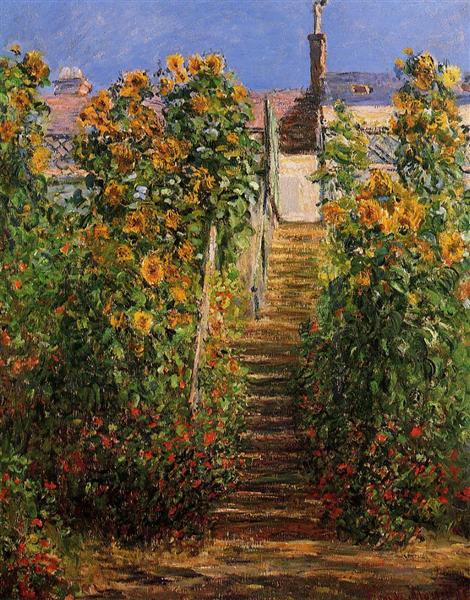説明
In The Steps at Vetheuil from 1881, Claude Monet encapsulates the essence of Impressionism through a captivating depiction of the landscape surrounding the River Seine in the town of Vetheuil, a place that held great personal significance for the artist. The work reflects Monet's mastery in capturing light, colour and atmosphere, underlining his deep appreciation for the changes that nature can offer at different times of day and in different weather conditions.
The composition of the painting is notable for its elegance and simplicity. In the foreground, a stone staircase descends towards the riverbank. This architectural element not only guides the viewer's gaze, but also symbolizes the link between humans and nature, a recurring theme in Monet's work. At the top of the stairs, one can notice the presence of a woman and a child, who seem to contemplate the landscape. Although their forms are almost spectral and miniaturized compared to the magnitude of the surroundings, their inclusion brings a sense of scale and humanity to the work, suggesting a personal connection with the landscape.
The colours used in this painting are vibrant and varied, a hallmark of Impressionism, which Monet mastered. The shades of green, blue and brown that represent the vegetation and water contrast with the warm hues of the sky, which is illuminated by soft yellow and pink brushstrokes, evoking a particular time of day, likely sunrise or sunset. The loose, impasto brushstrokes are a manifestation of his technique, which seeks to capture not only the image, but also the ephemeral feeling of the moment. This use of colour and light is representative of Monet's quest to capture the essence of the natural world, rather than its mere physical representation.
The work not only falls within a series of landscape paintings that Monet made in Vetheuil, but also aligns with his intention to explore the effects of light and atmosphere at different times of the day. Vetheuil, where Monet lived between 1878 and 1881, was a place intimately assimilated in his work; its landscapes, its seasonal changes and its surroundings were a constant source of inspiration. The series of paintings he made in this village reflects his commitment to the series and visual research.
The historical context of Impressionism, a movement that sought to break away from the strict rules of academia and traditional painting, is evident in this work. Monet, along with other artists such as Renoir and Pissarro, sought to express the immediacy of visual experience through his style. The Steps of Vetheuil is a testament to the impact that Impressionism had on the artistic practices of its time, promoting a more personal and emotive approach to art.
In conclusion, “Les Passes de Vetheuil” is not just a depiction of the landscape through the eyes of Claude Monet, but a manifestation of his unique perspective on nature and the human being’s place within it. The interplay of light, colour and form, together with the subtle inclusion of human figures, makes this work a brilliant example of Impressionism, inviting the viewer to immerse themselves in the atmosphere of tranquillity and contemplation that emanated from this corner of the world.
KUADROS ©, a famous painting on your wall.
Hand-made oil painting reproductions, with the quality of professional artists and the distinctive seal of KUADROS ©.
Painting reproduction service with satisfaction guarantee. If you are not completely satisfied with the replica of your painting, we will refund 100% of your money.

